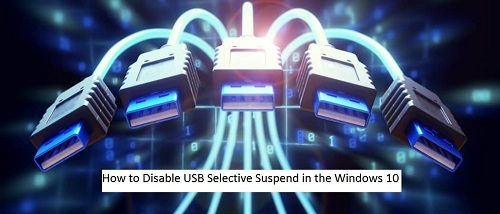How to Disable USB Selective Suspend in the Windows 10
Windows 10 comprises a feature of USB selective suspend that allows you to automatically place USB devices in the short power state when they are not in use. It is the necessary feature as it helps in extending battery life on the tablet or laptop. However, it also causes issues with the specific peripherals connected to the computer.
If the USB device is unable to work properly, then you may try to stop the selective suspend on Windows 10. It may cause the PC to consume extra power; however, it may also help in fixing and detecting the issue as well.

One thing that several users have no idea about the USB devices is what is going to happen as you maintain them connected but do not utilize them. For instance, in the case of handy computer like laptop and tablet, USB devices which are not in use are situated in the selective suspend.
This function was applied to Windows 10 to help the extended battery life as long as possible. Unluckily the lower power that causes performing problems with the specific peripherals and outcome in devices that are not working properly. If you have encountered the same problem, then you may select to stop the USB selective suspend feature of Windows 10.
It is going to make USB devices continually extend a similar quantity of power; however, you will surely free from such connectivity problems. The feature is not easy to run into the interface of Windows 10. If you need to disable the USB selective suspend in Windows 10, then you are on the right post. Read through the blog to follow the instructions.
How to Disable the USB Selective Suspend
If you have the connectivity problems with the USB peripherals on Windows 10, then you may apply these instructions to stop feature of USB selective suspend. If you want to disable the USB selective suspend in Windows 10, then abide by the given steps:
- Click on Start.
- Insert in control and then open Control Panel.
- Navigate to Hardware and Sound.
- Head over to the Power Options.
- See below the Selected plan and then choose the Change plan settings option.
- Click on the advanced power settings button.
- Enlarge the USB Settings section.
- Enlarge USB selective suspend setting section.
- Tap on Disabled.
- Press Apply.
- Hit the OK button.
If you are modifying the settings on the tablet or laptop, you will then see the 2 choices:
Plugged in or On Battery, so ensure to modify the settings properly.
Also, ensure to change the settings accordingly. By following the procedure, Windows 10 is not going to turn off the USB devices, which is connected to the PC. It may fix the issue that you may be facing because of the feature. USB selective suspend is around while for some time, and the same procedure is for Windows 7, 8, and also 8.1.
Aida Martin has diverse interests that range from writing to video games. She has always had a strong passion for writing. She likes to write about games, tech events, security, and whitepapers. Her vast and varied knowledge aided by her supreme writing skills, have made her a powerful writer at norton.com/setup.
Comments
Post a Comment